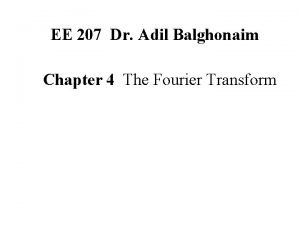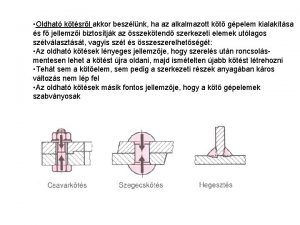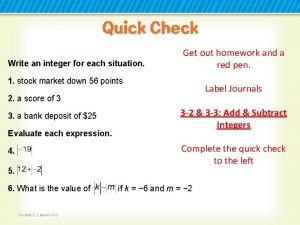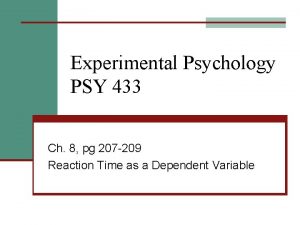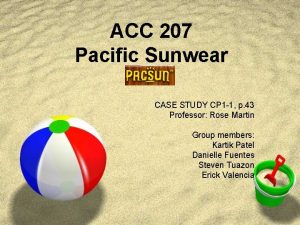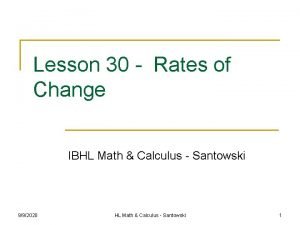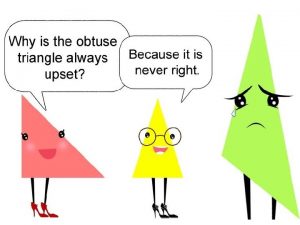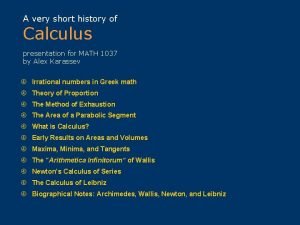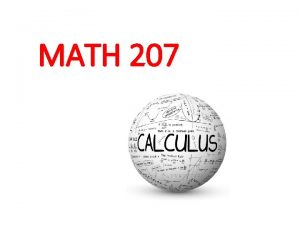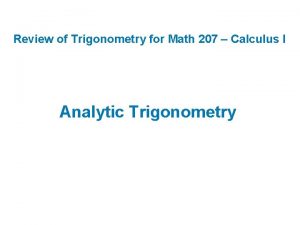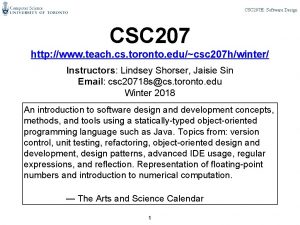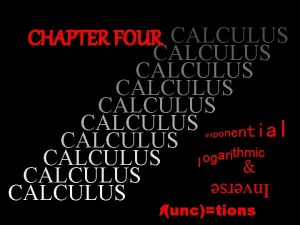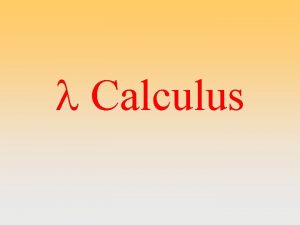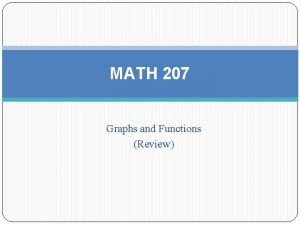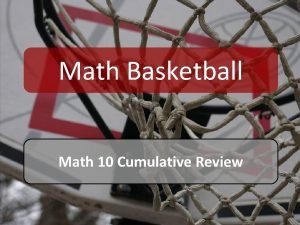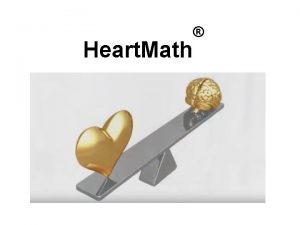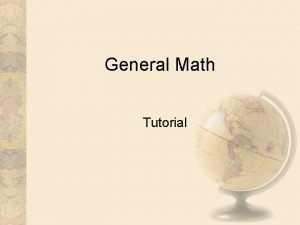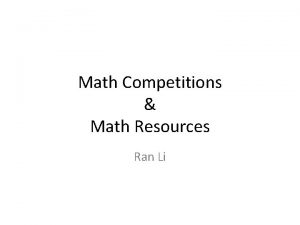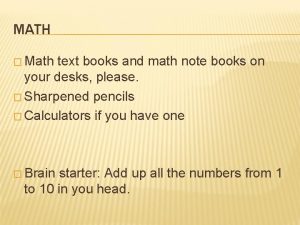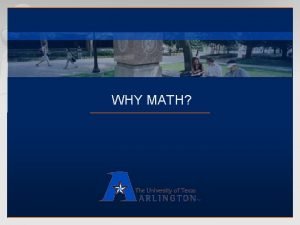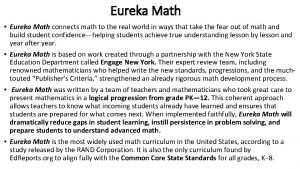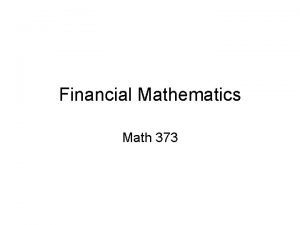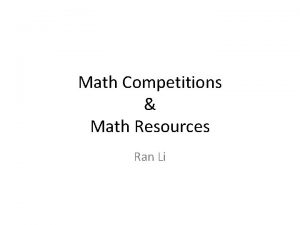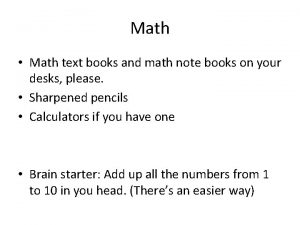MATH 207 The History Of Calculus Calculus in














































- Slides: 46

MATH 207

The History Of Calculus

Calculus in Engineering Civil Engineering For example, in hydraulic systems, basic fluid mechanics equations require calculus. Structural Engineering Electrical Engineering For example, structural analysis relating to seismic design requires calculus. Calculations of bearing capacity and shear strength of soil are done using calculus, as is the determination of lateral earth pressure and slope stability in complex situations. Computing voltages in electronic circuits requires the use of calculus differential equations

Mechanical engineering Many examples! Calculus is used for: • Evaluating surface areas of complex objects • Computing torques and forces • Analyzing fluid flow in hydraulic systems • … Aerospace Engineering For example, • computing thrust of rockets that function in stages, • modeling gravitational effects over time and space. Many other Engineering fields: Nuclear Engineering, Material Science, etc…



Calculus is also used in many more areas: • • Architecture Acoustics Politics Optics Music Sports Arts … Calculus is everywhere!

Class website: • http: //ougouag. com • Contains ALL course material: Ø Annoucements Ø Syllabus Ø Homework Assignments Ø Lecture Notes Ø MANY more resources…! • Bookmark it!

Brightspace: brightspace. ccc. edu • How do you log in? Ø With your ccc credentials (login and password) • DO it now! (on your tablet/phone…) • Set up your profile to get my messages. • I WILL BE USING BRIGHTSPACE TO POST ALL YOUR SCORES IN TESTS AND QUIZZES.

Syllabus • Let’s go over it in detail. • Please pay attention. • I will be giving you a short quiz next time about its contents!

A couple more things…

Food in class (!) • If you must eat, please choose items that are discreet and do not disturb class (no strong smells and crinkly noises!)

About you • At the end of today’s session: turn in the handout I gave you. • Fill in as much as is comfortable for you. All info will be appreciated and will help me to get to know you better. • Let’s go around and mention our Name and Special thing

Now let’s review a few things…

Several review links are posted on the class website! For example: Pre. Calculus Tutorials MATH 2. org Just Math Tutorials

Distance Formula Example: Find distance between (-1, 4) and (-4, -2).

Midpoint Formula Example: Find the midpoint from P 1(-5, 5) to P 2(-3, 1). Answer: (-4, 3)

Equations in two variables – Example: Circle Equations y r (x, y) (h, k) x

1. 1 Functions Copyright © Cengage Learning. All rights reserved.

Definition of a Function



It’s helpful to think of a function as a machine: The input is the independent variable, The output is the dependent variable.

Four Ways to Represent a Function § verbally (by a description in words) § numerically (by a table of values) § visually (by a graph) § algebraically (by an explicit formula)

Verbally (with words) or With Diagrams: Copyright © 2011 Pearson Education, Inc. Publishing as Pearson Addison-Wesley

Numerically: using Tables -

Visually: using Graphs -

Algebraically: using Formulas – There are several Categories of Functions:

The most common method for visualizing a function is its graph. If f is a function with domain D, then its graph is the set of ordered pairs: {(x, f (x)) | x D}

Theorem: Vertical Line Test A set of points in the xy - plane is the graph of a function if and only if a vertical line intersects the graph in at most one point.



Finding the Domain of a Function

Piecewise-defined Functions: Example:

A common Piecewise Defined Function: The absolute value function: f (x) = |x| x if x 0 –x if x < 0 f(x) = |x| =

Symmetry of a Function (Odd or Even) • If a function f satisfies f (–x) = f (x) for every number x in its domain, then f is called an even function. The graph of an even function is symmetric with respect to the y-axis • If f satisfies f (–x) = –f (x) for every number x in its domain, then f is called an odd function. The graph of an odd function is symmetric about the origin An even function Figure 19



Increasing and Decreasing Functions Where is the function increasing?

Where is the function decreasing?

Where is the function constant?


Local Maxima and Minima Local Max

Local Min

Average rate of change of a Function

from 0 to 1
 Iso/tc 207
Iso/tc 207 Article 207 tfeu
Article 207 tfeu Adil balghonaim
Adil balghonaim Msz 207
Msz 207 Write an integer for each situation worksheet
Write an integer for each situation worksheet Positives of the roman empire
Positives of the roman empire Pg 207
Pg 207 Oae207
Oae207 2conf
2conf Csc 207
Csc 207 Oecd 207
Oecd 207 Ae 207
Ae 207 Acc 207
Acc 207 Relational calculus calculator
Relational calculus calculator Math calculus
Math calculus History of calculus timeline
History of calculus timeline Calculus presentation
Calculus presentation Hit the button
Hit the button Hình ảnh bộ gõ cơ thể búng tay
Hình ảnh bộ gõ cơ thể búng tay Slidetodoc
Slidetodoc Bổ thể
Bổ thể Tỉ lệ cơ thể trẻ em
Tỉ lệ cơ thể trẻ em Gấu đi như thế nào
Gấu đi như thế nào Glasgow thang điểm
Glasgow thang điểm Bài hát chúa yêu trần thế alleluia
Bài hát chúa yêu trần thế alleluia Các môn thể thao bắt đầu bằng từ đua
Các môn thể thao bắt đầu bằng từ đua Thế nào là hệ số cao nhất
Thế nào là hệ số cao nhất Các châu lục và đại dương trên thế giới
Các châu lục và đại dương trên thế giới Công của trọng lực
Công của trọng lực Trời xanh đây là của chúng ta thể thơ
Trời xanh đây là của chúng ta thể thơ Mật thư tọa độ 5x5
Mật thư tọa độ 5x5 101012 bằng
101012 bằng Phản ứng thế ankan
Phản ứng thế ankan Các châu lục và đại dương trên thế giới
Các châu lục và đại dương trên thế giới Thơ thất ngôn tứ tuyệt đường luật
Thơ thất ngôn tứ tuyệt đường luật Quá trình desamine hóa có thể tạo ra
Quá trình desamine hóa có thể tạo ra Một số thể thơ truyền thống
Một số thể thơ truyền thống Cái miệng xinh xinh thế chỉ nói điều hay thôi
Cái miệng xinh xinh thế chỉ nói điều hay thôi Vẽ hình chiếu vuông góc của vật thể sau
Vẽ hình chiếu vuông góc của vật thể sau Thế nào là sự mỏi cơ
Thế nào là sự mỏi cơ đặc điểm cơ thể của người tối cổ
đặc điểm cơ thể của người tối cổ Giọng cùng tên là
Giọng cùng tên là Vẽ hình chiếu đứng bằng cạnh của vật thể
Vẽ hình chiếu đứng bằng cạnh của vật thể Fecboak
Fecboak Thẻ vin
Thẻ vin đại từ thay thế
đại từ thay thế điện thế nghỉ
điện thế nghỉ


